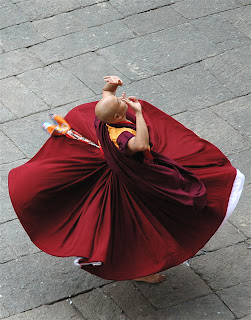Originally organized by the Honolulu Academy of Arts in conjunction with the Ministry of Home and Cultural Affairs of the Royal Government of Bhutan, The Dragon’s Gift: The Sacred Arts of Bhutan is one of the most ambitious and eagerly anticipated exhibitions of Buddhist art in many years. Bhutan is a tiny kingdom in the Himalayas, wedged between the two superpowers of China and India. But it survives as both an ancient independent kingdom and the worlds newest democracy. The Dragon’s Gift explores Bhutan’s cosmology through the window of its sacred visual arts and ritual dance (cham), using Buddhism as a lens through which to explore the full range of Bhutanese culture. The works of art are combined with an enactment of Bhutanese religious rituals to present a mirror of a living culture.
 Vajrabhairava is a wrathful form of Manjushri, the bodhisattva of wisdom
Vajrabhairava is a wrathful form of Manjushri, the bodhisattva of wisdom (* see Tom Christensen's blog for a delightful exposition of this "blue meanie)
The exhibition includes more than one hundred works of art. Exhibited materials include thangkas (textile mounted paintings), sculptures, metalwork, textiles, and ritual objects, all made for use in a Vajrayana (Tantric) Buddhist context.
 Monks practicing one of the many cham, or sacred dances.
Monks practicing one of the many cham, or sacred dances.
In a major innovation, the exhibition also explores the ancient ritual Buddhist dance and movement tradition known as
cham, as a fundamental manifestation of Bhutan’s religious culture.
Cham is a form of danced yoga in Tantric Buddhism. Indeed, “The Dragon’s Gift” is the first exhibition of its kind in having been jointly organized by art historians and dance historians. Unlike the situation in many other areas of the Himalayas, such as Tibet, where ancient traditions of
Cham are threatened (for example, in Tibet and Ladhakh), the Cham of Bhutan has been preserved largely intact. One of the primary contributions of “The Dragon’s Gift” is its exploration of the ancient arts of a living culture, and its demonstration that the visual arts and traditions of sacred movement are two manifestations of the same cosmology.
These parallel explorations are motivated by the realization that the Buddhist dances of Bhutan embody and convey the same ontological, mythological, and philosophical underpinnings embodied in the visual arts, which together reinforce the fundamental values and worldview of Bhutanese culture.
 Seated Goddess, posssibly Kongtsedemo (7-8th century), one of the twelve local goddesses knowsn as the twelve tenma who protect Buddhism.
Seated Goddess, posssibly Kongtsedemo (7-8th century), one of the twelve local goddesses knowsn as the twelve tenma who protect Buddhism.
Nearly all of the works of art presented in the exhibit are from active temples and monasteries and remain in ritual use. Most of the items are painted or textile thangkas or gilt bronze sculptures which date primarily from the 17th to the 19th centuries – a golden age in the Buddhist arts of Bhutan. Ranging from depictions of Tantric deities to individualized portraits of Buddhist masters, the exhibition presents outstanding works of art with a wide iconographic scope.
 Guru Dragpo Marches (19th Century, Ink and colors on cotton)
Guru Dragpo Marches (19th Century, Ink and colors on cotton)A visitor to the exhibit also becomes a participant as monks will be continuing their religious practices throughout the museum space. So, by visiting the museum you will obtain merit and lessen your negative karma (surely a good thing!). From Friday through Sunday (until the exhibit closes), two monks from a Bhutanese monastery will perform daily purification rituals and prayers (puja) for sacred objects in the exhibition. Watch them create offerings for a Buddhist altar installed in the museum court in an ancient practice of Buddhist rituals. To immerse oneself in this exhibit is to understand (to some extent), the Buddhist concept of time and the Bhutanese links with the past.
The present does not remain
The past and future do not exist
Wherever you look, you cannot see them
So the three times are called imperceptible.
 Dharma Protector Dorje Yudronma (19th century), a female deity who is one of the protectors of Bhutan.
Dharma Protector Dorje Yudronma (19th century), a female deity who is one of the protectors of Bhutan.There is an altar at one end of the courtyard, with numerous statues of the Buddha in niches above the altar and offerings in front. Along one wall is a section from a temple with prayer wheels which you can turn to offer prayers. I gave them a turn or two myself with a prayer for peace in these troubled times:
May all beings everywhere plagued
with sufferings of body and mind
quickly be freed from their illnesses.
May those frightened cease to be afraid,
and may those bound be free.
May the powerless find power,
and may people think of befriending
one another.
May those who find themselves in trackless,
Fearful wilderness--
the children, the aged, the unprotected--
be guarded by beneficent celestials,
And may they swiftly attain Buddha hood.
The lavishly illustrated catalogue is a "must buy" for anyone who wants to understand Buddhist and Bhutanese art, history, culture and religion. The twelve superb essays cover all aspects of the exhibit including conservation techniques and Buddist philosophy. It also includes a DVD of Cham dance performances, probably the first time these dances have been ever seen outside Bhutan.
200 Larkin St, SF: Through May 10, 2009 - check the website for a list of ongoing events organized about this exhibit which will include lectures, films and interactive activities for the whole family.
http://www.asianart.org/index.html7 Junipers:
http://7junipers.com/log/images courtesy of the Asian




























.jpg)


